Other common names: English—lungan, dragon eye; Spanish—mamoncillo chino, longana; Malaysian and Indonesian—leng keng; Thai—lam yai
Scientific name: Dimocarpus longan Lour.
Synonyms: Nephelium longan (Lam.) Carm.; Euphoria longana Steud.
Family: Sapindaceae
Relatives in the same family: Lychee, rambutan, pulasan, akee, Spanish lime, soapberry
Origin: Mayanmar (Burma), southern China, southwest India, Sri Lanka, Indochinese peninsula
Distribution: China, Taiwan, Thailand, Mayanmar, Cambodia, Vietnam, Laos, India, Australia, Kenya, some Central and South American countries, and South Africa. In the United States longan is grown in Hawaii, California and south Florida. The longan was introduced to the United States in 1903. Commercial acreage in southern Florida was planted in the 1990s and continues to the present.
Importance: Economically the longan is an important crop in southeast Asia and is of increasing importance in Florida.
Botanical Description
Tree: The longan is a symmetrical, evergreen tree with dense dark green foliage (Figure 1). Depending upon climate and soil type the tree may grow over 100 ft (31 m) tall. However, in south Florida, trees typically grow to 30–40 ft (9.1–12.2 m) in height and width. The crown tends to be round or oblong and the bark is corky.

Credit: Ian Maguire, UF/IFAS TREC
Leaves: The pinnately compound alternate leaves are dark green, shiny, leathery, up to 12 inches (30 cm) long with wavy margins and blunt pointed tips (Figure 2). There are 6 to 9 pairs of leaflets per leaf.
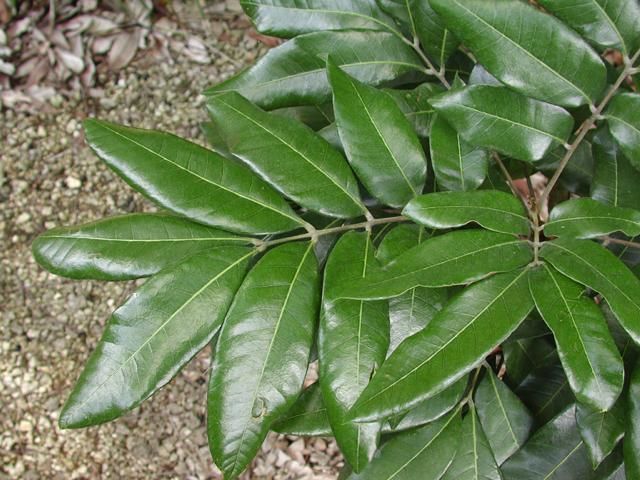
Credit: Ian Maguire, UF/IFAS TREC
Flowers: Inflorescences are terminal, 4 to 18 inches (10–45 cm) long, erect, and widely branched (Figure 3). The inflorescence is commonly called a panicle. Flowers on the panicle are held on numerous cymules on the many branchlets of the panicle. The flowers are small and have 5 to 6 sepals and petals, and are brownish yellow or greenish yellow, with a two-lobed pistil and usually 8 stamens. Panicles may carry a few to more than 350 fruit. There are 3 flower types in longan, staminate (functionally male), pistillate (functionally female) and hermaphroditic (bisexual). Flowering in each panicle occurs in progressive openings of staminate (male) flowers first, then hermaphroditic flowers functioning as females and then hermaphroditic flowers functioning as males.
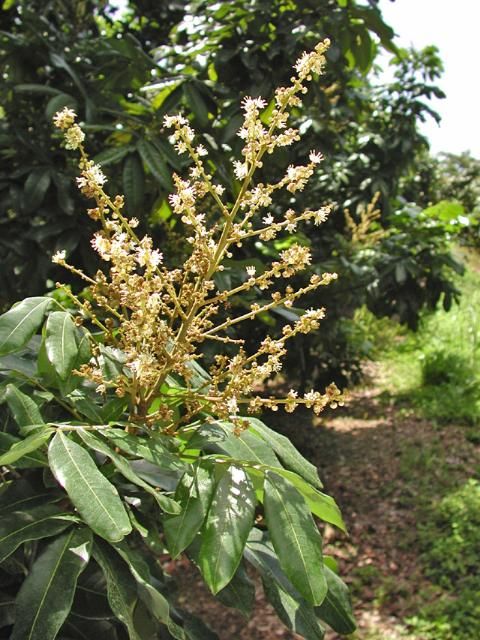
Credit: Ian Maguire, UF/IFAS TREC
Fruit: The drupaceous fruit are spherical to ovoid, ¾ to 1 7/16 inches (22–36 mm) in diameter and 0.21 to 0.67 oz (6–19 g) in weight (Figure 4). The peel is tan or light brown, thin, leathery and smoother than that of the lychee. The pulp is whitish and translucent; thin in large seeded fruits and medium thick to thick in others. Fruit have 1 seed; globular and shiny, brown to dark brown. The pulp does not adhere to the seed and is flavorful and sweet with 12-21% soluble solids. The time from flowering to harvest is 140 to 190 days.
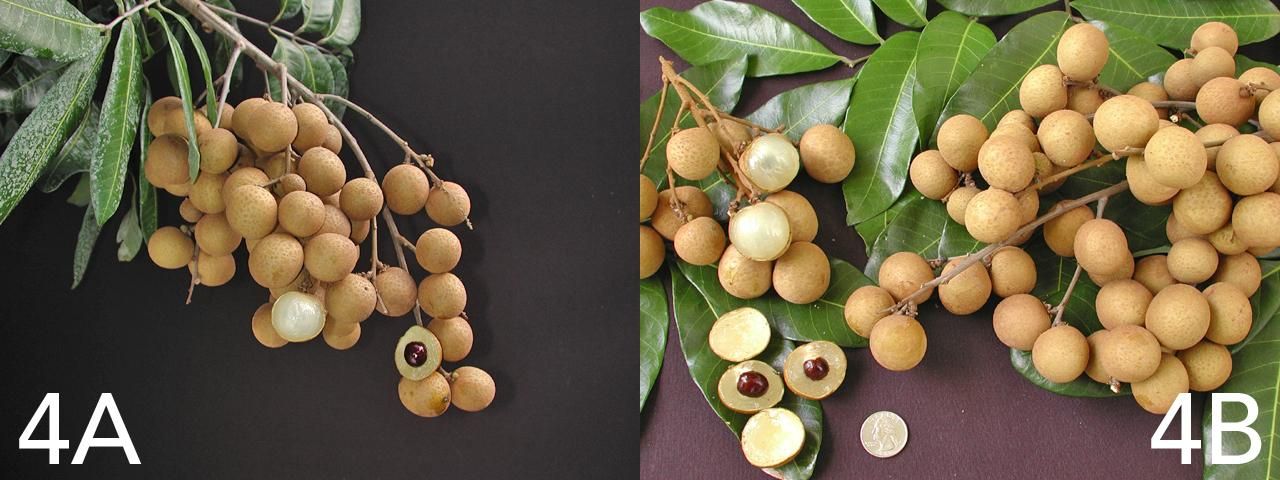
Credit: Ian Maguire, UF/IFAS TREC
Season of bearing: The main bloom season for longans in south Florida is from February/March through April and the beginning of May. Harvest is generally during June, July, or August. However, some cultivars will produce off-season blooms and fruit harvested 3 to 6 months later.
Varieties
There are numerous cultivars of longan; however, world-wide only 30 to 40 are grown commercially. Reliable bearing is the major production problem for longan throughout the world. In Florida, 99% of the acreage is planted with 'Kohala'. Other cultivars have been introduced, some for a long time and others recently (Table 1). A number of new and re-introductions including 'Edau' ('Daw'), 'Chompoo', 'Haew', and 'Biew Kiew' are under evaluation by several institutions and producers. However, nothing superior to 'Kohala' has been identified.
One of the recently introduced cultivars is named 'Diamond River'. This cultivar is from Thailand and is reported to fruit every year, be precocious, produce off-season, and produce a sizeable late season crop. However, fruit quality is only fair and the tree is very susceptible to limb breakage.
Climate
Longan is a subtropical tree well adapted to tropical climates with distinctive wet/dry periods and subtropical areas with a cool, nonfreezing fall/winter period. Longans are indigenous to lowland and middle elevations in southeast Asia and grow at elevations from sea level to 1500 feet (1.8–460 m).
Longans produce more reliably in areas characterized by low non-freezing temperatures (59°F; 15°C or less) and a dry period during the fall and winter (October–February). Warm temperatures (70–85°F; 21–29°C) during spring, followed by high summer temperatures (80–95°F; 27–35°C) and nonlimiting soil moisture are best for fruit development.
Warm and rainy winters are conducive to vegetative growth and reduce flowering and fruit production. Excessive rains during flowering cause flower drop and may reduce pollination and fruit set. Young longan leaves are sensitive to strong winds during vegetative flushing which may result in leaf dehydration, browning, and deformation.
Environmental Stress Physiology
Drought
Longan is tolerant of dry soil conditions. Withholding or reducing watering during the late summer/early fall through winter is recommended to stop or reduce excessive vegetative growth and enhance subsequent flowering during the spring. However, for optimum fruit production and quality, regular irrigation is recommended from flowering through harvest.
Flood
Longan is not tolerant of excessively wet or flooded soil conditions. When ambient temperatures are high, young trees may decline and die with as little as 5 to 10 days of flooding or constantly wet soil conditions.
Cold
Longan is slightly less cold tolerant than lychee. Young trees are very susceptible to freezing temperatures with severe damage at 29° to 31°F (-1 to -0.5°C) and may be killed at 26° to 28°F (-2 to -3°C). Older trees are more cold tolerant, but branches are injured at 25° to 26°F (-3 to -4°C) with very severe damage or death below 24°F (-4°C).
Wind
Longan trees are tolerant of windy conditions and young trees can generally be established on windy sites. Mature trees pruned to limit their height to 10 to 20 ft (3.1–6.1 m) are more likely to survive hurricane force winds. The most common damage from hurricane winds is toppling over of the trees and loss of most limbs. Windy, dry, cool weather during flowering desiccates flowers and reduces fruit set.
Salt
Longan is not tolerant of saline soil and water conditions. Symptoms of salt stress include marginal and tip necrosis of leaves, leaf browning and drop, stem dieback, and tree death.
Propagation
Longan may be grown from seed, however, cultivars do not come true from seed, may be slow to bear, and the fruit of inferior quality. Seedlings may be used for selection of new cultivars or rootstocks. Air layering (marcottage) is the most common propagation method used in Florida. April through August is the best time for air layering, and roots form within 10 to 12 weeks. Grafting onto seedling rootstock may be done by side veneer or cleft grafting. Seedlings are usually grafted when pencil size (3/8 inch; 8 mm) or larger stem diameter. Trees may be top-worked by grafting onto selected vigorous shoots. Trees may also be propagated by cuttings with mist and bottom heat.
Production (Crop Yields)
Seedling trees may take up to 6 years to bear fruit, whereas air layered trees may bear fruit 2 to 3 years after planting. In general, longan trees bear erratically (i.e., not every year) and in some years little to no fruit is produced. Yields from individual mature trees may range from 50 to over 500 lbs (23–227 kg).
Spacing
Longan trees grow fairly fast and at maturity are large trees. Homeowners should plant longan trees 22 to 25 ft (6.7–7.6 m) or more away from other trees and structures. Trees planted too close to other trees or structures may not grow normally or produce much fruit due to shading.
Soils
Longan trees thrive on various soil types provided they are well drained. They do well on sandy loams, sand, and calcareous, rocky soils of south Florida.
Planting a Longan Tree
Properly planting a longan tree is one of the most important steps in successfully establishing and growing a strong, productive tree. The first step is to choose a healthy nursery tree. Commonly, nursery longan trees are grown in 3 gallon containers and trees stand 2 to 4 ft (0.6–0.9 m) from the soil media. Large trees in smaller containers should be avoided as the root system may be "root bound". This means all the available space in the container has been filled with roots to the point that the root system becomes compacted within the container. Root bound root systems may not grow properly once planted in the ground.
Inspect the tree for insect pests and diseases and inspect the trunk of the tree for wounds and constrictions. Select a healthy tree and water it regularly in preparation for planting in the ground.
Planting may be done at any time in south Florida if there is access to water. Otherwise, the best time to plant is in late spring or early summer during the rainy season.
Site Selection
In general, longan trees should be planted in full sun for best growth and fruit production. Select a part of the landscape away from other trees, buildings and structures, and powerlines. Remember longan trees can become very large if not pruned to contain their size. Select the warmest area of the landscape that does not flood (or remain wet) after typical summer rainfall events.
Planting in Sandy Soil
Many areas in Florida have sandy soil. Remove a 3 to 10 ft (0.9–3.1 m) diameter ring of grass sod. Dig a hole 3 to 4 times the diameter and 3 times a deep as the container the longan tree has come in. Making a large hole loosens the soil adjacent to the new tree making it easy for the roots to expand into the adjacent soil. It is not necessary to apply fertilizer, topsoil, or compost to the hole. In fact, placing topsoil or compost in the hole first and then planting on top of it is not desirable. If you wish to add topsoil or compost to the native soil, mix it with the soil excavated from making the hole in no more than a 50-50 ratio.
Backfill the hole with some of the native soil removed to make the hole. Remove the tree from the container and place it in the hole so that the top of the soil media in the container is level with or slightly above the surrounding soil level. Fill soil in around the tree roots and tamp slightly to remove air pockets. Immediately water the soil around the tree and tree roots. Staking the tree with a wooden or bamboo stake is optional. However, do not use wire or nylon rope to tie the tree to the stake as they may eventually damage the tree trunk as it grows. Use a cotton or natural fiber string that will degrade slowly.
Planting in Rockland Soil
Many areas in Miami-Dade County have a very shallow soil and several inches below the soil surface is a hard calcareous bedrock. Remove a 3 to 10 ft (0.9–3.1 m) diameter ring of grass sod. Make a hole 3 to 4 times the diameter and 3 times a deep as the container the longan tree has come in. To dig a hole there are several options use a pick and digging bar to break up the rock or contract with a company that has augering equipment or a backhoe. Plant as described in the previous section.
Planting on a Mound
Many areas in Florida are within 7 ft or so of the water table and experience occasional flooding after heavy rainfall events. To improve plant survival consider planting fruit trees on a 2 to 3 ft (0.6–0.9 m) (1.2–3.1 m) high by 4 to 10 ft diameter mound of native soil.
After the mound is made, dig a hole 3 to 4 times the diameter and 3 times a deep as the container the longan tree has come in. In areas where the bedrock nearly comes to the surface (rockland soil) follow the recommendations for the previous section. In areas with sandy soil follow the recommendations from the section on planting in sandy soil.
Care of Longan Trees in the Home Landscape
A calendar outlining the month-to-month cultural practices for longan is shown in Table 2.
Fertilizer
A month after planting spread 1/4 lb (113 g) per tree of a young tree fertilizer, such as 6-6-6 (% nitrogen-% phosphate-% potassium) with minor elements with 20 to 30% of the nitrogen from organic sources. Repeat this every 6 to 8 weeks for the first year. Then, gradually increase the amount of fertilizer to 0.5, 0.75, 1.0 lb etc., (227 g, 341 g, 454 g, etc.) as the trees grow. Four to 6 dry fertilizer applications per year may be made up to the third year (Table 3).
A foliar fertilizer mix composed of minor nutrients (manganese, zinc, boron, and molybdenum) and magnesium may be applied 4 to 6 times per tree per year any time from April to September. For trees in acid to neutral soils apply iron sulfate at 0.25 to 1 oz per tree to the soil 2 to 4 times per year. In alkaline soils with a high pH, drench the soil with iron chelate 2 to 3 times per year from June through September. To make a soil drench, mix 0.5 to 0.75 oz (14–21 g) of iron chelate with 4 to 5 gallons (14–19 liters) of water and pour on to the soil adjacent to the tree trunk.
For mature trees, 2.5 to 5.0 lbs of fertilizer per application 2 to 3 times per year is recommended. The fertilizer should be applied just prior or at bloom, perhaps during late spring, and again just before or at harvest. The fertilizer mix should also include phosphate (P2O5) and potash (K2O); use a 6-6-6, 8-3-9 or similar material.
Irrigation (Watering)
Young trees should be irrigated regularly to facilitate tree establishment and growth. Once trees begin to bear (3 to 4 years after planting), trees should be irrigated regularly from flowering through harvest. Research from other regions has suggested that mild drought stress during the fall (September or October) and early winter enhances flowering in late winter or early spring.
Insect Pests
Longans have a few insect problems in south Florida. The most common pests are the lychee webworm and several scale insects. The lychee webworm (Crocidosema new species) attacks emerging shoots and panicles, flowers, and young fruit and if left uncontrolled drastically reduces fruit set and crop yields. Scales include the banana shaped (Coccus acutissimus) and barnacle (Ceroplastes spp.) scales, which attack mostly the underside of leaves and the phi- lephedra scale (Phillephedra tuberculosa) that attacks leaves and fruit. Adult Sri Lankan weevil (Myllocerus undecimpustulatus undatus), citrus blue-green weevil (Pachnaeus litus), little leaf notcher (Artipus floridanus) and diaprepes weevil (Diaprepes abbreviatus) feed on leaves and their larvae may feed on roots. They are mostly a problem in marl and sandy soils. Please contact your local UF/IFAS Extension office for current control recommendations.
Diseases
There are no major disease problems of longan at the present time. Red alga (Cephaleuros virescens) attacks limbs and shoots and is most prevalent during high humidity, warm, rainy weather. Symptoms include dark gray to reddish-rust colored patches or spots on bark and/or leaves. In severe infections, leaf drop and stem die back occur. Parasitic lichen (Strigula sp.) may parasitize leaves. Symptoms include white star-shaped spots on leaf surfaces. This lichen colonizes leaves reducing their ability to photosynthesize. Please contact your local UF/IFAS Extension office for current control recommendations.
Weeds
Weeds compete for water and nutrients and will slow tree establishment. Prior to planting trees, remove sod from the area the tree is to be planted in. Grass and weeds should be kept away from the tree trunk. Placing a 2 to 4 inch (5–10 cm) thick layer of mulch will suppress weed and grass growth and hold soil moisture.
Other Pests
Birds such as boat-tailed crackles (Cássidix mexicánus) and monk parakeets (Myiopsitta monachus) may feed on the fruit. Bagging the fruit in paper bags and netting may be used to exclude these birds if they become a major problem.
Longan Trees and Lawn Care
Longan trees in the home landscape are susceptible to trunk injury caused by lawn mowers and weed eaters. Maintain a grass-free area 2 to 5 feet or more away from the trunk of the tree. Never hit the tree trunk with lawn mowing equipment and never use a weed eater near the tree trunk. Mechanical damage to the trunk of the tree will result in weakening the tree and if severe enough can cause the tree to dieback or die.
Roots of mature longan trees spread beyond the drip-line of the tree canopy and heavy fertilization of the lawn adjacent to longan tree is not recommended and may reduce fruiting and or fruit quality. The use of lawn sprinkler systems on a timer may result in over watering and cause longan tree to decline. This is because too much water, too often is being applied which results in root rot.
Mulch
Mulching longan trees in the home landscape helps retain soil moisture, reduces weed problems adjacent to the tree trunk, and improves the soil near the surface. Mulch with a 2 to 6 inch (5–15 cm) layer of bark, wood chips, or similar mulch material. Keep mulch 8 to 12 inches (20–30 cm) from the trunk.
Tree Training and Pruning
Young Trees
Young longan trees are usually not trained in south Florida. However, young longan trees typically produce 2 to 5 long branches; making a scraggly tree structure with few terminals. However, several techniques will improve tree structure and bearing surface area. At planting or soon afterward, remove limbs with a narrow crotch angle. To force new shoot growth and increase the number of new shoots either bend long upright limbs to a horizontal position by tying or head back upright limbs. Shoot tip removal (removing 1–2 inches of the end of new shoots), once or twice during spring and summer will increase branching and make the tree more compact.
Mature Trees
Tree size control is done to facilitate spraying and picking and to maintain high light levels from the bottom to the top of the tree. It also greatly reduces the potential damage sustained due to hurricanes and strong winds. As trees mature, most of the pruning is done to control tree size (height and width), and to maintain production of the lower tree canopy and light on all sides of the canopy.
Longan trees in the home landscape may be pruned by hand or with gas/oil or electrical cutting tools by selectively thinning out a few moderate and small sized limbs each year. Trees kept 10 to 15 ft high (3.1–4.6 m) and 15 to 30 ft (4.6–9.1 m) wide are easier to care for and pick. They are also less likely to topple during strong winds. If the canopy of the tree becomes too dense, selective removal of some branches will increase air circulation and light penetration.
Fruit Thinning
Longan fruit set varies greatly among trees and years. In some years, individual longan panicles set in excess of 300 fruit. However, panicles with 150 or more fruit usually produce small fruit. Removing about 50% of the set fruit during the spring usually results in a large increase in fruit size. Thinning is best done when fruit are ¼ to ½ inches (6–12 mm) in diameter and consists of removing one half to two-thirds of the distal (terminal) end of each panicle.
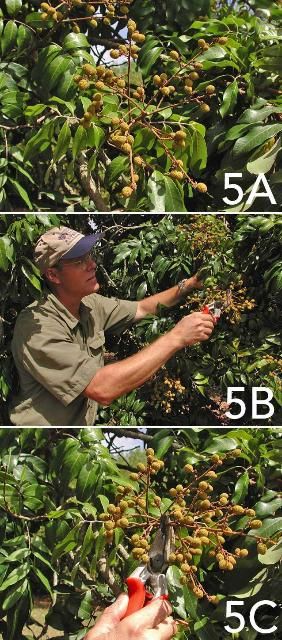
Credit: Ian Maguire, UF/IFAS TREC
Harvest, Ripening, and Storage
The longan harvest season in south Florida is from the middle of July to early September but is mainly in August. At maturity, the fruit will be an intense tan color. The main ripeness indicator is pulp sweetness; this occurs before removing the fruit from the tree. Fruit that is 1¼ inches (32 mm) or greater in diameter with good flavor is most desirable. Once removed from the tree, the fruit will not increase in sweetness.
Fruit is harvested by hand, with pruning shears or a pole with a cutter that holds the entire cluster. Usually, a portion of the branch behind the fruit-bearing panicle (about 1 ft; 30 cm) is cut. Harvested fruit should be placed in the shade immediately and then cooled as soon as possible. Longan fruit have a relatively short shelf life when stored at ambient temperatures of 75–85°F (24–29°C). Fruit harvested at home may be placed in plastic bags and kept in the refrigerator for 5 to 7 days.
Uses and Nutritional Value
Longan trees make excellent specimen or shade trees and enhance the landscape with their dark-green foliage. Longans produced in south Florida are consumed fresh or are frozen for later consumption (Figure 6). Fruit may be frozen whole in polyethylene bags or air-tight containers. In other producing countries fruit are dried and canned. This helps to popularize the fruit by extending the normally very short season. The fruit is a good source of potassium and low in calories (Table 4).
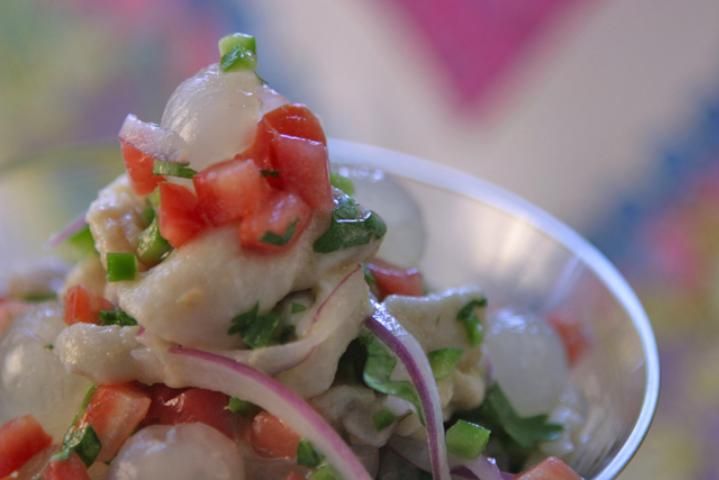
Credit: Ian Maguire, UF/IFAS TREC